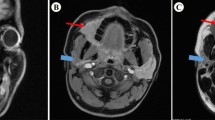Abstract
Sublingual gland herniation into the submandibular space through a mylohyoid muscle defect is a common anatomical variation; however, salivary gland cancers that arise from a herniated sublingual gland have not been described yet. Here, we report three patients with salivary gland cancers originating from a herniated sublingual gland. All tumors were detected as palpable submandibular masses, located anterior to the submandibular gland, medial to the mandible, and lateral to the mylohyoid muscle, with contact with the sublingual gland through a mylohyoid muscle defect. Intraoperative findings confirmed that the masses were derived from herniated sublingual glands. Pathological examination showed one case of mucoepidermoid carcinoma and two cases of adenoid cystic carcinoma. Imaging findings of the tumor location, in addition to the continuity with the sublingual gland through the mylohyoid muscle defect, are crucial for accurately diagnosing the tumor origin, which is essential for determining the appropriate clinical management.



Similar content being viewed by others
References
Dalgic A, Karakoc O, Karahatay S et al (2013) Submandibular triangle masses. J Craniofac Surg 24:e529–e531. https://doi.org/10.1097/SCS.0b013e3182a238f9
Patel S, Bhatt AA (2018) Imaging of the sublingual and submandibular spaces. Insights Imaging 9:391–401. https://doi.org/10.1007/s13244-018-0615-4
Hopp E, Mortensen B, Kolbenstvedt A (2004) Mylohyoid herniation of the sublingual gland diagnosed by magnetic resonance imaging. Dentomaxillofac Radiol 33:351–353. https://doi.org/10.1259/dmfr/31454077
Iwai T, Sugiyama S, Ishikawa S, Mitsudo K (2023) Sublingual gland herniation masquerading as submandibular lesion. Indian J Surg 85:438–439. https://doi.org/10.1007/s12262-022-03431-2
Yang HC, Kim SY, Kim SK, Oh CS, Chung IH, Nam KI (2016) A cadaveric study on mylohyoid herniation of the sublingual gland. Eur Arch Otorhinolaryngol 273:4413–4416. https://doi.org/10.1007/s00405-016-4095-1
Chee JRT, Chia TK, Goh JPN, Chuah KL, Li H (2021) An unusual submandibular tumour. Ann Acad Med Singap 50:195–197. https://doi.org/10.47102/annals-acadmedsg.2020462
Yabuuchi H, Fukuya T, Tajima T, Hachitanda Y, Tomita K, Koga M (2003) Salivary gland tumors: diagnostic value of gadolinium-enhanced dynamic MR imaging with histopathologic correlation. Radiology 226:345–354. https://doi.org/10.1148/radiol.2262011486
White DK, Davidson HC, Harnsberger HR, Haller J, Kamya A (2001) Accessory salivary tissue in the mylohyoid boutonnière: a clinical and radiologic pseudolesion of the oral cavity. AJNR Am J Neuroradiol 22:406–412
Lee JY, Lee HY, Kim HJ et al (2016) Plunging ranulas revisited: A CT study with emphasis on a defect of the mylohyoid muscle as the primary route of lesion propagation. Korean J Radiol 17:264–270. https://doi.org/10.3348/kjr.2016.17.2.264
Tian Z, Li L, Wang L, Hu Y, Li J (2010) Salivary gland neoplasms in oral and maxillofacial regions: a 23-year retrospective study of 6982 cases in an eastern Chinese population. Int J Oral Maxillofac Surg 39:235–242. https://doi.org/10.1016/j.ijom.2009.10.016
Funding
The authors have no relevant financial or non-financial interests to disclose.
Author information
Authors and Affiliations
Corresponding author
Ethics declarations
Ethics approval
Our institutions do not require ethics approval for case reports.
Informed consent
Informed consent is obtained from all patients.
Conflicts of interest
All authors declare that they have no conflicts of interest.
Additional information
Publisher's Note
Springer Nature remains neutral with regard to jurisdictional claims in published maps and institutional affiliations.
Rights and permissions
Springer Nature or its licensor (e.g. a society or other partner) holds exclusive rights to this article under a publishing agreement with the author(s) or other rightsholder(s); author self-archiving of the accepted manuscript version of this article is solely governed by the terms of such publishing agreement and applicable law.
About this article
Cite this article
Miyasaka, Y., Hiyama, T., Kuno, H. et al. Imaging of salivary gland cancers derived from a sublingual gland herniated into the submandibular space: a report of three cases. Neuroradiology (2024). https://doi.org/10.1007/s00234-024-03360-9
Received:
Accepted:
Published:
DOI: https://doi.org/10.1007/s00234-024-03360-9



